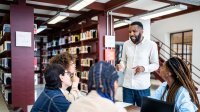The Benefits of Cocreating a Course With Students
Collaboratively designing courses with middle and high school students can lead to deep engagement and transferable knowledge.
Your content has been saved!
Go to My Saved Content.There are many reasons why we see low student engagement in the classroom. Maybe we’re nearing summer break, or grappling with enduring impacts of pandemic disruptions to learning, or working with students traditionally undersupported in academic environments, or navigating a nebulous curriculum.
I’ve wrestled with all of the above scenarios throughout my career, and in the face of them, I’ve returned to this truism: Innovation is born of need and thrives in chaos. While I was trying to get my head around planning and preparation, I realized I had a rare opportunity: students who desperately needed a more motivating approach and the freedom to transform my instruction.
Through experimentation, I found that the more I shifted responsibility and freedom to my students, the more energized and engaged they were. Paolo Freire said, "Teaching is not just transferring knowledge. It is creating possibilities for the construction and production of knowledge.” In that vein, I discovered the power of cocreating courses with students using participative teaching practices—a replicable approach outlined below.
Planning a CoCreated Course
In designing my first cocreated course—a senior Media and Communications class for students who struggled in their coursework or needed an English credit for graduation—I made certain decisions in advance: I set objectives and decided to use a digital portfolio for formative assessment and a presentation with an oral defense for the final exam.
But the rest of the course remained mostly unplanned, true to participative pedagogy—the collaborative design of teaching and learning environments by facilitators and learners through organic inquiry. When most of the course is open-ended, students have genuine possibilities to produce their own knowledge and skills.
Of course, it also means taking a risk.
At the start of the course, I found it difficult to engage in participative practices with students conditioned to traditional teaching methods rooted in compliance and control. It took time to break down old habits and unlearn teacher-centric practices with my students.
However, two strategies helped us gain momentum: first, centering relationships to build mutual trust over time; and second, using gentle prompting and offering ideas and choices about what students might learn and do to achieve stated objectives. These strategies established safety and structure that allowed students freedom to share their ideas.
Implementing and Iterating
My experience taught me that there are three key elements of a successful cocreated course: creating a genuine space for student contribution, empowering students’ engagement with technology, and sharing monitoring and assessment.
I involved students directly in decision-making regarding content, projects, deadlines, and physical classroom setup. This gave them personal accountability, motivation, and drive, as we had shared ownership of the course and were all stakeholders in its success.
For many students, this course facilitated their first use of technology for an educational purpose—and giving them space and time to explore relevant programs boosted engagement and equipped them with transferable skills, like finding accurate and reliable information from internet sources.
We used tools like project management and productivity trackers, social media, communication platforms, and collaborative boards. And students used content creation software and our learning management system to host their digital portfolios.
Examples from the Classroom
Perhaps the most magical part of the course was making collective decisions regarding tests, quizzes, and projects. Students created products and engaged in peer review and group discussions to establish criteria that I used to build the mark schemes.
For example, students needed to create a public service announcement video on an issue of their choice, like drink-spiking or mask-wearing. They observed exemplars from the previous cohort as well as from well-known campaigns, like the Ad Council’s “Love Has No Labels,” and came up with some criteria, like “Must show a call to action.”
Sometimes this process didn’t go so well. For example, in one project, despite my disagreement, students voted to remove “Shows evidence of planning and revision” from the mark scheme. One student commented in her final exam that the biggest reason her final product was not very good was because she hadn’t planned it out adequately, presenting a rich learning moment for everyone.
Portfolios created a more natural learning process, as students chose when and how they were assessed. Students put artifacts of learning into their digital portfolio with descriptive text and a reflective commentary on how and why the work showed growth, competencies, specific objectives, and new knowledge. They included which habits of mind were exercised and wrote goals for continued learning. And I encouraged them to have another go at any of the objectives on which they had underperformed. As a result, students expressed feeling less stress and anxiety over measurement and grades. In short, they felt in control of their learning.
Of course, this approach requires scaffolding: I found it helpful to set clear expectations and guidelines with students around deadlines and communication; provide ongoing, personalized, actionable feedback and support through frequent check-in meetings; and share purposeful, flexible objectives while remaining open to creative means of achieving them.
Thoughts for the Future
Inspired by my experience with participative teaching and students’ requisite engagement, I now have the goal of applying a collaborative structure to some of my more traditional, content-heavy courses.
Inviting students to cocreate the curriculum shifts ownership and accountability to learners and fosters democratic teaching practices, without sacrificing the objectives and goals that align learning experiences.
Adaptability is part of what makes a cocreated course agile and exciting. My students have shown me that it is possible, that deep and enduring learning can occur when we take a risk by reversing traditional classroom roles, and that there are many ways to engage with knowledge individually and together.
